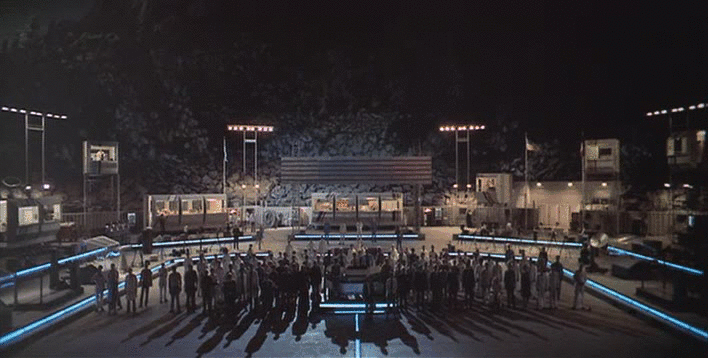Spielberg, Truffaut and Me – An Actor’s Diary, by Bob Balaban

In the summer of 1976, during the first weeks of the filming of Close Encounters of the Third Kind, Francois Truffaut, who played the extraterrestrial specialist Claude Lacombe, was at work on a book about actors—tentatively titled Hurry Up and Wait. The legendary auteur-director and founder of the French New Wave had appeared in several of his own films as well as those of others, but he had trouble finding the book’s focus, and the it was never finished.
As it happens, there was a book written on that subject during that shoot, not by Truffaut, but by his co-star Bob Balaban. Spielberg, Truffaut and Me: An Actor’s Diary was published in 2002, and though it might not offer what Truffaut had in mind, it’s a fascinating look behind the curtain. At the time of the filming, Balaban was already established, with film credits like Midnight Cowboy and Catch-22. Now an acclaimed producer and director as well, Balaban’s hunch that Close Encounters was a singular project, and one that offered a fascinating backstory, turned out to be right.
In prose that is at once light, revealing, and earnest, Balaban recounts the process, from his own casting as David Laughlin, the cartographer whose conversant French finds him suddenly recruited as Lacombe’s interpreter, to location shoots in Wyoming, Alabama, the Mojave Desert and India. Balaban faithfully records the daily reality —the boredom, the creativity, and on-the-spot inventiveness, as well as the bonds that were forged in what became a close community far from home (for more on that, see Truffaut’s classic film about filmmaking, Day for Night).
Balaban’s daily entries reveal a lot about an actor’s daily process, which involves a lot of down time. “Acting in a movie,” Balaban writes, “especially one with the scope of Close Encounters, can be a difficult experience. You spend very little of your time doing what you are actually hired to do—act.”
It’s fascinating too, to read about the complexities of making a film of this magnitude. Close Encounters was made pre-CGI, and each special effect had to be constructed in analog. This included the alien ships designed by Bob Alves and his artistic team. The details include the effects for the now-iconic clouds generated by the mothership (a mix of paint roiling in fresh and salt water), as well as the otherworldly atmospheric effects caused by their innumerable lights, a haziness created by filming the models through veils of smoke in a black velvet room.

Spielberg’s previous film, Jaws, brought the director acclaim, blockbuster status, studio backing, and the exorbitant budget for CE3K. While that first blockbuster’s central prop was the famous (and famously malfunctionin) shark, Close Encounters had a sound stage of unprecedented size. The famous airstrip behind Devil’s Tower, site of the mothership’s landing and subsequent contact (of the fourth kind) with humans on earth, was constructed in an immense abandoned dirigible hanger on a disused air base, Brookley Field, outside Mobile, Alabama. As Balaban notes on first seeing the set when he arrives
“…spread out below me is an astonishing sight: a long, concrete landing field stretches out for what looks like miles. It is surrounded by piles of rocks which look exactly like the rocks at the base of Devil’s Tower. It’s as if we never left Wyoming.”
As Spielberg proudly shows off the upper reaches of the immense set to his principal cast, Balaban writes, “The stairs are really shaking now, and I hold on to the wooden support slats with both hands. Nobody seems to mind. Truffaut is fascinated by all of this. I try to translate [Truffaut’s French] for Steven, but my translation gets vaguer as my vertigo increases.”
Balaban looks too at the more ordinary detail of what it’s like to work on location. This actor’s diary shows us Truffaut and Balaban, on their first night meeting in Gillette, Wyoming, walking out of a local restaurant because a country-western band is blaring, and Truffaut can’t stand loud music during dinner. He shows us the extras who are fired because they drink too much beer, and mount a protest when they learn they have to cut their hair in order to look like government aerospace workers. We see Balaban and Truffaut, grabbing lunch in an A-frame cafe at the base of Devil’s Tower, which for the film sports a sign that reads “Decontamination Camp.” Balaban also reveals his regret at the ordinary trousers and jacket he brought as the costume for his character of Laughlin, after seeing the superbly tailored clothes Truffaut brought from Paris.
We learn too that Balaban was not completely confident in his ability to speak French, and the carefully practiced lines he brought to the audition. We learn how Truffaut was self-conscious, and often good-humored, about his English, and this mutual challenge around language forged a bond between the two, one that continued until Truffaut’s death in 1984.

Balaban’s hunch that Spielberg’s extraordinary film, with its groundbreaking visuals and singular cast, warranted daily journaling, was prescient. The film has become a classic of its time, notable too as the only American film in which Truffaut appeared, despite a lifelong devotion to and knowledge of American cinema.
There are no earth-shaking revelations in Spielberg, Truffaut and Me, but the account is filled with lovely detail of what it’s like to make your living as an actor, and live a life that centers on making films.
—Lauren Alwan
